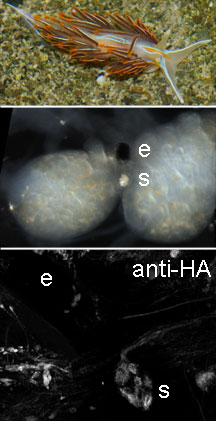Research Projects
Lobster Baits | Biofouling | Collaborations
Neuroethology of navigation in the sea slug Tritonia diomedea
|
Navigation is a key behaviour performed by all motile animals. We work with Tritonia because this slug is amenable for a variety of experiments (both behavioural and neurophysiological) that allow us to test the role of single neurons in navigational behaviours. Like most animals, Tritonia is primarily concerned with mates, prey and predators. Tritonia navigates relative to these targets using odours, water flow, and possibly the earth's magnetic field. Our long term goal is to understand how these different sensory cues are integrated together to produce the coordinated responses we see as the animals seek out food and possible mates, while avoiding predators. We plan to tackle this problem use several approaches:
|
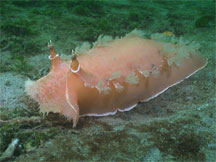
The Nudibranch Tritonia Tritonia striking two sea pens. 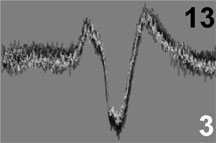 A neuron responsive to predator odour. |
Peripheral sensory systems in the snail Lymnaea stagnalis and sea slug Aplysia californica
|
Collaboration with Roger Croll
Sensory systems are a key component in the control of most behaviours. At present, our understanding of gastropod sensory systems is limited. Previous research on the peripheral nervous system has created a patchwork of information encompassing different sensory cell types scattered across different species. Our goal is to map the sensory cells present in the lips and tentacles of Lymnaea stagnalis as well as the siphon of Aplysia californica. We plan to create a catalog of sensory cell types and then match those types to their modality (mechanosensory or chemosensory). Our approaches here include:
|
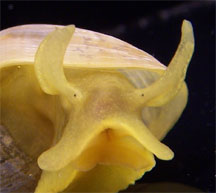
The Snail Lymnaea 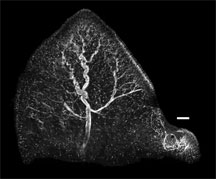
A backfilled Lymnaea tentacle |
Neurotransmitters in Hermissenda statocysts
The vestibular organs in gastropods are statocysts. These have been studied extensively in Hermissenda crassicornis to understand the cellular mechanisms of learning. The sensory hair cells in the statocysts are known to use the neurotransmitter GABA in synapses with eye photoreceptors. However, the hair cells likely also contain a number of other neurotransmitters of unknown function. For example, we have evidence histamine is also present in most of the hair cells. We plan two approaches to study this complexity:
|
|
Navigational strategies for finding odour sources
Many animals use odour-gated rheotaxis to find odour sources. In other words, the animals head upstream when they detect an attractive odour. This strategy is successful because it is the flow that transports the odour from the source to the animal. However, how do animals cope with flows that vary in direction such that they could be led astray? One possibility might be to use a magnetic compass to follow the last-known heading from which odour was detected to reach the source. Our goal is to explore this possibility using:
|
Slugs with a magnetic compass (black) are better at finding an odour source than those that simply head upstream (blue) |
Lobster navigation and bait preferences.
Lobster navigate using odours and waterflow, and fisherman exploit this by baiting their traps to attract the lobsters. However, little is known about optimal bait types and the important odour found in plumes that attract lobster. Our goal is to build understanding of lobster responses to bait by:
We anticipate our results will be useful for lobster fisherman attempting to improve the cost-effectiveness of their bait use. |
Biofouling and Antifouling Coatings
Biofouling, or the growth of organisms on man-made surfaces, affects many industries: food production, oil and gas, and shipping, among many others. As part of the StFX Centre for Biofouling Research, we are exploring novel non-toxic options for reducing biofouling, particularly focused on cold water marine habitats. The WyethLab's role is primarily involved in field surveys of biofouling and field tests of candidate coatings that may reduce biofouling. Current projects include:
We anticipate our results will be useful for local marine industries in reducing their fouling mitigation costs. |
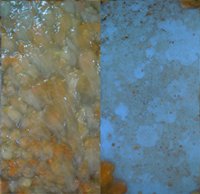 Two plates deployed simultaneously: a control plate (left) completely fouled byC. intestinalis and a siloxane material plate (right) with greatly reduced fouling. Two month progression of fouling on multiple replicates for controls (left) versus 3 experimental coating types |
Collaborations
- Ryan Lukeman: Analytical modelling of chemical-based aquatic navigation
- Roger Croll: Comparative gastropod neurobiology
- Shaun Cain and Jim Murray: Magnetosensation and mechanosensation in Tritonia
- Darren Derksen: chemical ecology of the nudibranch Flabellina
- Jim Williams: Lobster and green crab responses to lobster bait
Past Collaborations
- Roger Croll and Frank Smith: Quantitative analysis of Zebrafish behaviour
- George Mackie: Alternative conduction pathways in tunicates; Polyorchis neuroanatomy
- Dennis Willows, Karl Böhringer, Anupama Govindarajan: Implantable neural intracellular recording devices
- Gitai Yahel: Suspension feeder diets
